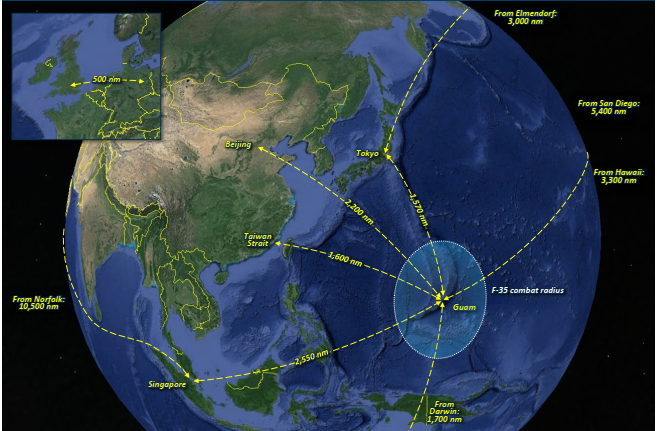
美國以為利用PDI.在關島就可以控制亞太地區的防禦攻勢,美國夢是永遠無法實現的.
美國202006企圖以3艘航空母艦挑戰中國,秀肌肉作秀,美國太平洋艦隊已經夕陽西下,毫無戰鬥力,過半數的美軍感染COVID-19.新冠疫病,強行出征,如何執行戰爭?
美國白宮內部政黨鬥爭白熱化遲早玩完美國政府.
20200611日獲得美國國會參議院軍事委員會通過的參院版本的“2021財年國防授權法”,2021財年美國國防開支將達7405億美元。其中參議院首次在NDAA內設立的“太平洋威懾倡議”(Pacific Deterrence Initiative)獲得69億美元的撥款。它批准在2021財年撥款14億美元,2022財年撥款55億美元。該法案要求美國國防部長為所有這些資金制定具體支出計劃。
美國將通過PDI.向亞太地區大舉增加國防軍事佈署準備攻擊中國.
PDI:Pacific Deterrence Initiative
提高太平洋地區聯合部隊的殺傷力,包括改進針對可能攻擊美軍基地、作戰地點和其它關鍵基礎設施的戰區巡航導彈、彈道導彈和高超音速導彈的主動與被動防禦能力。
通過從大型、集中和未加固的基礎設施過渡到小型、分散、有彈性和適應性的基地,增強印太地區聯合部隊的設計和態勢;增加遠征機場和港口的數量;加強預先部署燃料、彈藥、設備和物資;提高區域內的分布式後勤和維護能力,以確保在持續多域攻擊下的後勤保障。
加強聯盟和夥伴關係,以提高能力、改善互操作性和信息共享,並支持信息行動能力,重點是遏制有害影響。
主要是針對中國的PDI將遵循主要針對俄羅斯的“歐洲威懾計劃”(European Deterrence Initiative)的形式。自2014年克里米亞事件之後,“歐洲威懾計劃”已耗資220億美元。.
美國大兵已經重新整編調整,起程前往亞太地區,包括日本,南韓,菲律賓等地區佈署,其中台灣地區保密,至少需要佈署1營的海軍陸戰隊等兵力.
除了“太平洋威懾倡議”(PDI)之外,美國參議院NDAA議案也鼓勵美國空軍在印太地區建立F-35戰鬥機的運作地點;要求分配足夠的資源,優先保護可能受到“特別是來自中國”的新型導彈攻擊的空軍基地;要求五角大樓提交報告,說明在美軍駐扎海外時如何減輕來自華為和中興等供應商的風險。
據美國《國防新聞》20200403日報道,按照美國2020財年國防授權法的要求,美軍印太司令戴維森在202003月中旬之前提交了履行其在NDAA下使命及保持對中國軍事優勢所需的“願望清單”,從2021財年到2026財年,總共需要超過200億美元。美國《國防新聞》稱這些需求為PDI的基礎。
傳聞美國有意重新佈署B-52H.長程戰略轟炸機,於南韓,日本,專門針對中國,目前駐紮關島的3個轟炸機大隊太多,要分流出去移防.


JI & CG.牠們2人是標準的惡劣豬仔議員.
Jim Inhofe/Cory Gardner的這篇文章可謂是為參議院即將通過的《2021 財政年度國防授權法》(National Defense Authorization Act, NDAA 2021)所做的信心喊話。文章指出,明年度的《國防授權法》將設立新的「太平洋威懾倡議」(Pacific Deterrence Initiative, PDI),既更新美國對印太地區的承諾,也補充 2018 年國會通過的《亞洲再保證倡議法》(Asia Reassurance Initiative Act, ARIA)。
牠們2人是標準的豬仔議員,結合相關反中團體人士,在美國國會內翻雲覆雨的惡搞中國,藉以謀利.美國共和黨籍聯邦參議員Jim Inhofe/Cory Gardner)於20200702日聯名在美國《外交家》雜誌發表文章,論及中國在太平洋強勢擴張時美國應該抱有的印太策略。文章指出美國及盟國必須在當前局勢中有所選擇,而「北京會盡其所能確保正確的選擇絕不會是輕鬆的選擇」。
文章以澳洲為例來說明何謂「正確的力量」。作為美國的盟國,澳洲已經為正確的選擇付出艱難的代價,在承受中國的強勢壓迫和霸凌的同時,依舊堅持調查武漢肺炎的起源、堅持貿易開放、拒絕犧牲基本價值,這一切都使得澳洲成為全球的典範。中國或許從喜馬拉雅山脈到南中國海都橫行霸道,但澳洲的存在向世人證明了自由開放的印太地區可能存在著正確的力量,而美國則必須要提供盟友必要的支持。
中國DF-26.導向飛彈可以函蓋第一島鏈至第二島鏈的所有美國軍事目標,令美國恐懼,只有強迫南韓,日本及台灣,裝設反導向飛彈系統的雷達站系統,說的難聽些,上述那3國,就是美國在太平洋島鏈計劃中的擋箭牌,替美國遮攔中國飛彈.
PDI:內外結合防禦作戰概念旨在利用西太平洋第一島鏈及第二島鏈的地理防禦位置,構建一個全新的作戰概念美國版的反介入/區域拒止,削弱、延遲、阻斷對手力量投送。內外結合防禦作戰概念的核心含義是:在第一島鏈的島嶼上部署陸基反艦、防空反導、電子戰等武器,作為「內部」作戰力量,遏止對手的行動;在第一島鏈外部署遠程機動海空打擊武器,作為「外部」作戰力量,實施突防打擊。通過內外結合在西太地區構築反應靈活、生存能力強的大戰略縱深防禦體系。戰時取代當前的遠征作戰模式,迅速遏止對手進攻,即使無法取勝,也要避免對手快速實現既定軍事目標,為後續行動爭取時間,營造對美國有利的態勢。
CHINA DF-ICBM .SHOT TO USA
平時展示強大的防禦能力,增大對手軍事行動的代價,迫使對手另尋緩和緊張局勢的出路。然而在好的計劃百密一疏,日本已經看出破綻,所以日本拒絕佈署購買美國的反彈道飛彈系統的雷達設備及相關基地建造設施等,即使簽約金認賠錢,也不要,這樣一來就證明出美國強迫南韓,購買佈署的THHAD.防空反彈道飛彈系統,一點都無效也無用,而且耗費巨大的電力供應等等,如果傳言屬實那麼就證明日本為什麼要求退貨,不裝置美國的反彈道飛彈系統的雷達設備.
美國只是紙上談兵的紙老虎,但是不可否認美國人的計劃雖好,可是依然無法改變,中國的強勢崛起,也就是說計劃趕不上變化.贊
The Pacific Deterrence Initiative: Peace Through Strength in the Indo-Pacific.
The credibility of American deterrence rests on a simple foundation. America prevents wars by convincing its adversaries they cannot win. Secretary of Defense Jim Mattis said it succinctly: Deterrence is achieved when the enemy decides, “Not today. You, militarily, cannot win it, so don’t even try it.” Currently, in the Indo-Pacific, that foundation of deterrence is crumbling as an increasingly aggressive China continues its comprehensive military modernization.
This is not a partisan issue. Five years ago, Secretary of Defense Ash Carter warned that China was modernizing its military “to try to close the gap and erode our superiority in every domain.” Then, two years ago, Mattis assessed that’s exactly what happened, stating that America’s “competitive edge has eroded in every domain of warfare … and it is continuing to erode.” Even more bluntly, the bipartisan National Defense Strategy Commission report cautioned, “America’s military superiority…has eroded to a dangerous degree” to the point that “the U.S. military could lose the next state-versus-state war it fights.”
The best way to protect U.S. security and prosperity in Asia is to maintain a credible balance of military power. But America’s ability to do so is at risk. And it’s not just U.S. interests at stake. Allies and partners in the Indo-Pacific are watching closely, and wondering whether they will be able to count on America.
What the Pacific Deterrence Initiative Will Do?
The Pentagon is taking challenges in the Indo-Pacific seriously, and has made some important progress implementing the National Defense Strategy in the region. That’s especially true when it comes to rebuilding readiness and investing in modernization. Unfortunately, the progress to date has been insufficient to achieve the “urgent change at significant scale” that is required. The Pacific Deterrence Initiative will improve the implementation of the National Defense Strategy in the Indo-Pacific, and incentivize the Pentagon to better prioritize the region in its annual budget process.
The Pacific Deterrence Initiative would serve the same purpose, allowing Congress and the Pentagon to view the defense budget through a regional warfighting lens while increasing the visibility of options to advance U.S. priorities in the Indo-Pacific.
Investments in theater missile defense, expeditionary airfield and port infrastructure, fuel and munitions storage, and other areas will be key to America’s future force posture in the Indo-Pacific. As one example, it doesn’t matter how many F-35s the military buys if very few are stationed in the region, their primary bases have little defense against Chinese missiles, they don’t have secondary airfields to operate from, they can’t access prepositioned stocks of fuel and munitions, or they can’t be repaired in theater and get back in the fight when it counts. The Pacific Deterrence Initiative will incentivize increased focus on posture and logistics, and help measure whether these requirements are being matched with resources.
The Pacific Deterrence Initiative is Only a First Step:
The Pacific Deterrence Initiative will not be a panacea. It will not solve every military problem America faces in the Indo-Pacific, let alone the numerous non-military challenges the United States faces there. It is clear that China presents a challenge that requires a comprehensive response that includes a focus on economic security, international development, diplomacy, human rights and democratic norms, and multilateral cooperation. Moreover, while the Pacific Deterrence Initiative is a regionally-focused initiative, we recognize that the challenge from China is global in scale. But it is an essential step to reorganize U.S. thinking and resources around the key priorities for the joint force, and restore the credibility of American deterrence in the Indo-Pacific. The Pacific Deterrence Initiative will help ensure that America’s adversaries know that whether it’s today or tomorrow, there will never be a good day to test America’s military.
Clearly aimed at China! U.S. sets up Pacific Deterrence Initiative."
1. To increase the lethality of coalition forces in the Pacific region, including improving active and passive defenses against ballistic and hypersonic missiles for battlefield cruises, bases, locations of operations, and other critical infrastructure.
2. The transition from a large, centralized, unconsolidated infrastructure to a smaller, decentralized, resilient and adaptable infrastructure enhances the design and posture of the Joint Force in the Indo-Pacific region; Increased expeditionary airfield and port capabilities; Strengthen the pre-positioning of forwarding stocks of fuel, ammunition, equipment, and supplies; Improve distributed logistics and maintenance capabilities in the region to ensure the maintenance of logistics in the face of ongoing multi-domain attacks.
3. Strengthen alliances and partnerships to enhance capacity, improve interoperability and information sharing, and support information operations capabilities with a focus on combating pernicious influence.























